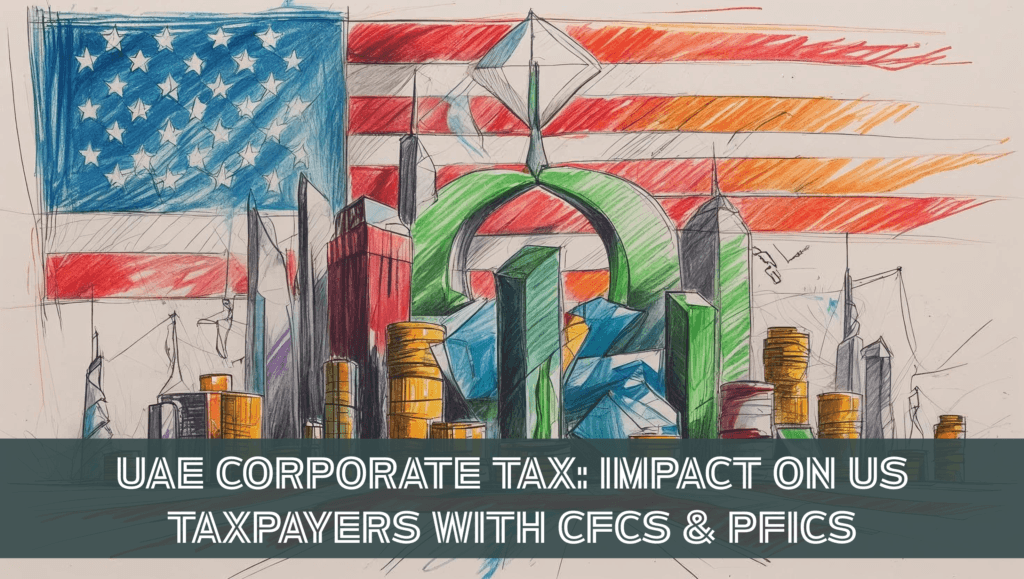
We Make Tax Filing A Breeze
Home » UAE Corporate Tax: Impact on US Taxpayers with CFCs & PFICs

For years, the United Arab Emirates (UAE) was famous as a tax-free business hub. But that’s changing. The UAE has now introduced a Federal Corporate Tax (CT) of 9% on annual profits over AED 375,000 — bringing it closer to global tax norms.
If you’re a US citizen, green card holder, or resident who owns a UAE company, this change could affect you more than you might think. Paying the UAE tax is only part of the story. The US has its own rules for taxing foreign companies — and they can easily lead to unexpected tax bills and big penalties if you don’t understand how they work.
In this guide, we’ll break down how the new UAE Corporate Tax interacts with the US rules for Controlled Foreign Corporations (CFCs) and Passive Foreign Investment Companies (PFICs)
Unlike many countries, the US taxes its citizens and residents on their worldwide income, no matter where they live or run a business.
So when you own part of a foreign company — like a UAE company — the IRS wants to make sure you’re not using it to stash profits offshore and delay paying US tax.
Before this new tax, UAE businesses could be entirely tax-free — which often triggered special US anti-deferral rules. With the new 9% UAE Corporate Tax, that “zero tax” situation is gone — but the US rules don’t disappear overnight.
The US tax treatment of your UAE company depends mainly on whether it’s considered a CFC, a PFIC, or both.
A Controlled Foreign Corporation (CFC) is any foreign company where:
Example:
Let’s say you and three other US citizens each own 25% of a UAE company. Together, US persons own 100% so it’s definitely a CFC.
A Passive Foreign Investment Company (PFIC) is any foreign company that meets either of these tests:
Example:
If your UAE company mostly holds stocks, bonds, or rental property for investment without much active business it probably qualifies as a PFIC.
So what happens if your UAE entity falls into one (or both) of these buckets? The IRS has two different sets of rules.
If your UAE company is a CFC, you may owe US tax on its profits every year — even if the money stays abroad. Here’s how:
The good news? The UAE’s new 9% corporate tax counts as a creditable income tax under US rules. So you can claim a Foreign Tax Credit (FTC) to offset part of your US tax on the same profits.
If the UAE tax rate were high enough — about 90% of the US corporate rate — you might even be able to skip GILTI altogether. But at 9%, you probably don’t qualify to opt out.
If your UAE company is a PFIC, things can get expensive fast — especially if you don’t make a special election.
Under the default PFIC rules, any distributions or gains are taxed under the “Excess Distribution” regime. Here’s how it works:
Plus, you owe an interest charge for the deferral.
Before the UAE introduced its corporate tax, your UAE company’s profits were tax-free there — which meant the entire amount was exposed to US tax under GILTI and Subpart F.
Now, the 9% UAE tax helps offset some of your US tax liability through the Foreign Tax Credit. This can reduce — or in some cases, eliminate — the additional US tax on that income.
However, if your company is a PFIC, the UAE tax only helps so much. While you can still claim a credit on actual distributions, the punitive default rules and interest charges stick around unless you make a proper election.
Whether your UAE company is a CFC, a PFIC, or both — you have to tell the IRS about it.
To learn more about how you can reduce your taxes and save money, check out the helpful resources on our blog or contact us today to schedule a consultation.